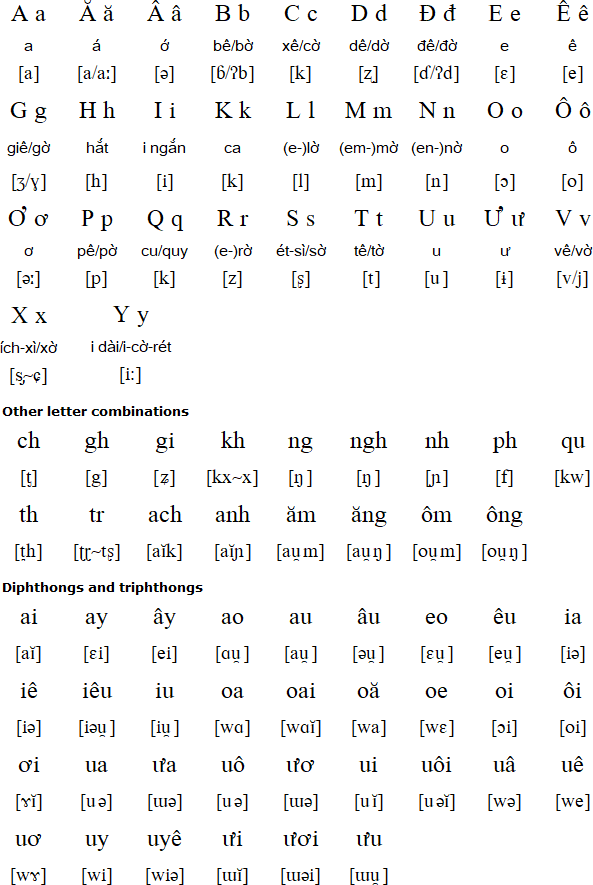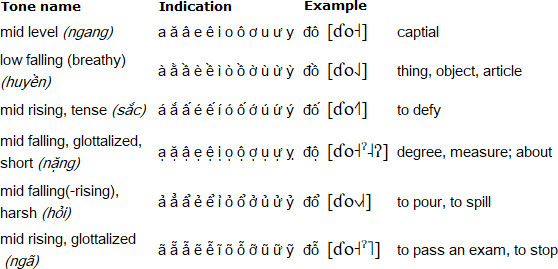Vietnamese (tiếng việt / 㗂越)
Vietnamese is an Austroasiatic language spoken by about 82 million people
mainly in Vietnam. There are also Vietnamese speakers in the USA, China,
Cambodia, France, Australia, Laos, Canada and a number of other countries.
Vietnamese has been the official language of Vietnam since the country gained
independence from France in 1954.
Vietnamese was originally written with a Siniform (Chinese-like) script
known as Chữ-nôm (𡨸喃) or
Nôm (喃). At first most Vietnamese literature was essentially Chinese
in structure and vocabulary. Later literature developed a more Vietnamese
style, but was still full of Chinese loan words. The greatest literary
work in Vietnamese is Kim Van Kieu, the ‘Tale of Kieu’, a romance
written by Nguyen-Du (1765-1820).
Chữ-nôm was used until the 20th century. Courses in the
Chữ-nôm script were available at Ho Chi Minh University until
1993, and the script is still studied and taught at the Han-Nôm Institute in Hanoi,
which has recently published a dictionary of all the nôm characters.
During the 17th century, Roman Catholic missionaries introduced a Latin-based
orthography for Vietnamese, Quốc Ngữ (national language),which
has been used ever since. Until the early 20th century, Quốc Ngữ
was used in parallel with Chữ-nôm. Today only Quốc
Ngữ is used.
Vietnamese alphabet and pronunciation

Notes
- The letters “F”, “J”, “W” and “Z” are not part of the Vietnamese
alphabet, but are used in foreign loan words. “W” (vê-đúp)”
is sometimes used in place of “Ư” in abbreviations. In informal
writing, “W”, “F”, and “J” are sometimes used as shorthands for “QU”,
“PH” and “GI” respectively. - The digraph “GH” and the trigraph “NGH” are basically replacements
for “G” and “NG” that are used before “I”, in order to avoid confusion
with the “GI” digraph. For historical reasons, they are also used before
“E” or “Ê”. - G = [ʒ] before i, ê, and e, [ɣ] elsewhere
- D and GI = [z] in the northern dialects (including Hanoi), and [j]
in the central, southern and Saigon dialects. - V is pronounced [v] in the northern dialects, and [j] in the southern dialects.
- R = [ʐ, ɹ] in southern dialects
Vietnamese is a tonal language with 6 tones. These tones are marked
as follows:

You can hear how to pronounce the Vietnamese letters and tones at:
www.seasite.niu.edu/Vietnamese/Guide_to_Pronunciation/alphabet/alphabet_system.htm
Sample text in Vietnamese
![]()
A recording of this text by Phan Tuấn Quốc (from south Vietnam)
A recording of this text by Nguyễn Văn Thắng (from north Vietnam)
Translation
All human beings are born free and equal in dignity and rights. They are
endowed with reason and conscience and should act towards one another in a
spirit of brotherhood.
(Article 1 of the Universal Declaration of Human Rights)
